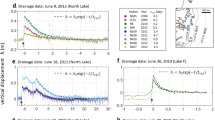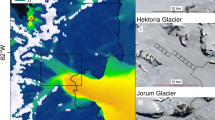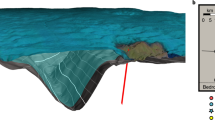Abstract
Predictions of the Greenland Ice Sheet’s response to climate change are limited in part by uncertainty in the coupling between meltwater lubrication of the ice-sheet bed and ice flow1,2,3. This uncertainty arises largely from a lack of direct measurements of water flow characteristics at the bed of the ice sheet. Previous work has been restricted to indirect observations based on seasonal and spatial variations in surface ice velocities4,5,6,7 and on meltwater flux8. Here, we employ rhodamine and sulphur hexafluoride tracers, injected into the drainage system over three melt seasons, to observe subglacial drainage properties and evolution beneath the Greenland Ice Sheet, up to 57 km from the margin. Tracer results indicate evolution from a slow, inefficient drainage system to a fast, efficient channelized drainage system over the course of the melt season. Further inland, evolution to efficient drainage occurs later and more slowly. An efficient routing of water was established up to 41 km or more from the margin, where the ice is approximately 1 km thick. Overall, our findings support previous interpretations of drainage system characteristics, thereby validating the use of surface observations as a means of investigating basal processes.
This is a preview of subscription content, access via your institution
Access options
Subscribe to this journal
Receive 12 print issues and online access
$259.00 per year
only $21.58 per issue
Buy this article
- Purchase on Springer Link
- Instant access to full article PDF
Prices may be subject to local taxes which are calculated during checkout


Similar content being viewed by others
References
Gillet-Chaulet, F. et al. Greenland Ice Sheet contribution to sea-level rise from a new-generation ice-sheet model. Cryosphere Discuss. 6, 2789–2826 (2012).
Vaughan, D. G. & Athern, R. Why is it so hard to predict the future of ice sheets? Science 315, 1503–1504 (2007).
Solomon, S. et al. Contribution of Working Group I to the Fourth Assessment Report of the Intergovernmental Panel on Climate Change (Cambridge Univ. Press, 2007).
Joughin, I. et al. Seasonal speedup along the western flank of the Greenland Ice Sheet. Science 320, 781–783 (2008).
Bartholomew, I. D. et al. Seasonal evolution of subglacial drainage and acceleration in a Greenland outlet glacier. Nature Geosci. 3, 408–411 (2010).
Bartholomew, I. D. et al. Seasonal variations in Greenland Ice Sheet motion: Inland extent and behaviour at higher elevations. Earth Planet. Sci. Lett. 307, 271–278 (2011).
Palmer, S., Shepherd, A., Nienow, P. & Joughin, I. Seasonal speedup of the Greenland Ice Sheet linked to routing of surface water. Earth Planet. Sci. Lett. 302, 423–428 (2011).
Bartholomew, I. D. et al. Supraglacial forcing of subglacial drainage in the ablation zone of the Greenland ice sheet. Geophys. Res. Lett. 38, L08502 (2011).
Van de Wal, R. S. W. et al. Large and rapid melt-induced velocity changes in the ablation zone of the Greenland Ice Sheet. Science 321, 111–113 (2008).
Shepherd, A. et al. Greenland Ice Sheet motion coupled with daily melting in late summer. Geophys. Res. Lett. 36, L01501 (2009).
Hoffman, M. J., Catania, G. A., Neumann, T. A., Andrews, L. C. & Rumrill, J. A. Links between acceleration, melting, and supraglacial lake drainage of the western Greenland Ice Sheet. J. Geophys. Res. 116, F04035 (2011).
Sundal, A.V. et al. Melt-induced speed-up of Greenland ice sheet offset by efficient subglacial drainage. Nature 469, 521–524 (2011).
Schoof, C. Ice-sheet acceleration driven by melt supply variability. Nature 468, 803–806 (2010).
Iken, A. & Bindschadler, R. A. Combined measurements of subglacial water pressure and surface velocity of Findelengletscher, Switzerland: Conclusions about drainage system and sliding mechanism. J. Glaciol. 32, 101–119 (1986).
Nienow, P. W., Sharp, M. & Willis, I. C. Seasonal changes in the morphology of the subglacial drainage system, Haut Glacier d’Arolla, Switzerland. Earth Surf. Process. 23, 825–843 (1998).
Jansson, P. Dynamics and hydrology of a small polythermal valley glacier. Geogr. Ann. 78A, 171–180 (1996).
Mair, D. et al. Hydrological controls on patterns of surface, internal and basal motion during three spring events: Haut Glacier d’Arolla, Switzerland. J. Glaciol. 49, 555–567 (2003).
Das, S. B. et al. Fracture propagation to the base of the Greenland Ice Sheet during supraglacial lake drainage. Science 320, 778–781 (2008).
Seaberg, S. Z., Seaberg, J. Z., Hooke, R. LeB. & Wieberg, D. Character of the englacial and subglacial drainage system in the lower part of the ablation area of Storglaciären, Sweden, as revealed by dye-trace studies. J. Glaciol. 34, 217–227 (1988).
Hubbard, B. & Nienow, P. Alpine subglacial hydrology. Quat. Sci. Rev. 16, 939–955 (1997).
Bingham, R. G., Nienow, P. W., Sharp, M. J. & Boon, S. Subglacial drainage processes at a High Arctic polythermal valley glacier. J. Glaciol. 51, 15–24 (2005).
Smart, P. L. & Laidlaw, I. M. S. An evaluation of some fluorescent dyes for water tracing. Wat. Resour. Res. 31, 15–33 (1977).
Watson, A. J., Liddicoat, M. I. & Ledwell, J. R. Perfluorodecalin and sulphur hexafluoride as purposeful marine tracers: Some deployment and analysis techniques. Deep-Sea Res. 34, 19–31 (1987).
Clark, J. F., Schlosser, P., Stute, M. & Simpson, H. J. SF6−3He tracer release experiment: A new method of determining longitudinal dispersion coefficients in large rivers. Environ. Sci. Technol. 30, 1527–1532 (1996).
Dillon, K. S., Corbett, D. R., Chanton, J. P., Burnett, W. C. & Kump, L. Bimodal transport of a waste water plume injected into saline ground water of the Florida Keys. Ground Wat. 38, 624–634 (2000).
Rigby, M. et al. History of atmospheric SF6 from 1973–2008. Atmos. Chem. Phys. 0, 10305–10320 (2010).
Upstill-Goddard, R. C. & Wilkins, C. S. The potential of SF6 as a geothermal tracer. Wat. Resour. Res. 29, 1065–1068 (1995).
Smeets, C. J. P. P. et al. A wireless subglacial probe for deep ice applications. J. Glaciol. 58, 841–848 (2012).
Allen, C. IceBridge MCoRDS L2 Ice Thickness [2010, 2011]. Boulder, Colorado, USA: NASA DAAC at the National Snow and Ice Data Center. Digital media. http://nsidc.org/data/irmcr2.html (2010, updated current year).
Nienow, P., Sharp, M & Willis, I. Velocity–discharge relationships derived from dye tracer experiments in glacial meltwaters: Implications for subglacial flow conditions. Hydrol. Process. 10, 1411–1426 (1996).
Acknowledgements
This work was supported by the Leverhulme Trust (Phillip Leverhulme Prize to J.L.W.), UK NERC grant NE/H023879/1 to J.L.W., NERC NE/F021380/1 grant to P.N., NERC grant NE/G005796/1 to A.H, financial support from the Greenland Analogue Project and SKB/Positiva to A.H., and Moss Scholarships to T.C. and I.B. We thank the Atmospheric Chemistry Research Group at the University of Bristol who aided with SF6 analysis in the early stages of the project. We acknowledge the use of ice thickness data collected by the NASA IceBridge project. We thank Hozelock for supplying hoses, and are grateful to the many field assistants who have contributed to the collection of field data.
Author information
Authors and Affiliations
Contributions
D.M.C. designed the tracer experiments in the field and conducted tracer data analysis, developed the model of drainage evolution and co-wrote the manuscript. J.L.W. led the project, designed the tracer experiments in the field and conducted tracer data analysis, and co-wrote the manuscript with D.M.C. G.P.L., S.V. and J.T. were responsible for SF6 analysis by gas chromatography and method development. P.N., D.M.C., A.S., T.C. and I.B. contributed discharge and dye tracing data, and input to writing of the manuscript. E.B.B. contributed to field logistics and input to writing of the manuscript. A.H. was responsible for in-field support of the campaign, provided ice thickness data and input to writing of manuscript.
Corresponding author
Ethics declarations
Competing interests
The authors declare no competing financial interests.
Supplementary information
Supplementary Information
Supplementary Information (PDF 4887 kb)
Rights and permissions
About this article
Cite this article
Chandler, D., Wadham, J., Lis, G. et al. Evolution of the subglacial drainage system beneath the Greenland Ice Sheet revealed by tracers. Nature Geosci 6, 195–198 (2013). https://doi.org/10.1038/ngeo1737
Received:
Accepted:
Published:
Issue Date:
DOI: https://doi.org/10.1038/ngeo1737
This article is cited by
-
Widespread partial-depth hydrofractures in ice sheets driven by supraglacial streams
Nature Geoscience (2023)
-
Threshold response to melt drives large-scale bed weakening in Greenland
Nature (2022)
-
Hydraulic transmissivity inferred from ice-sheet relaxation following Greenland supraglacial lake drainages
Nature Communications (2021)
-
Large subglacial source of mercury from the southwestern margin of the Greenland Ice Sheet
Nature Geoscience (2021)
-
Iceberg melting substantially modifies oceanic heat flux towards a major Greenlandic tidewater glacier
Nature Communications (2020)



